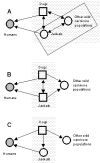Identifying reservoirs of infection: a conceptual and practical challenge
- PMID: 12498665
- PMCID: PMC2738515
- DOI: 10.3201/eid0812.010317
Identifying reservoirs of infection: a conceptual and practical challenge
Abstract
Many infectious agents, especially those that cause emerging diseases, infect more than one host species. Managing reservoirs of multihost pathogens often plays a crucial role in effective disease control. However, reservoirs remain variously and loosely defined. We propose that reservoirs can only be understood with reference to defined target populations. Therefore, we define a reservoir as one or more epidemiologically connected populations or environments in which the pathogen can be permanently maintained and from which infection is transmitted to the defined target population. Existence of a reservoir is confirmed when infection within the target population cannot be sustained after all transmission between target and nontarget populations has been eliminated. When disease can be controlled solely by interventions within target populations, little knowledge of potentially complex reservoir infection dynamics is necessary for effective control. We discuss the practical value of different approaches that may be used to identify reservoirs in the field.
Figures


Comment in
-
When is a reservoir not a reservoir?Emerg Infect Dis. 2003 Nov;9(11):1495-6. doi: 10.3201/eid0911.030088. Emerg Infect Dis. 2003. PMID: 14725261 Free PMC article. No abstract available.
References
Publication types
MeSH terms
LinkOut - more resources
Full Text Sources
Other Literature Sources
Medical
